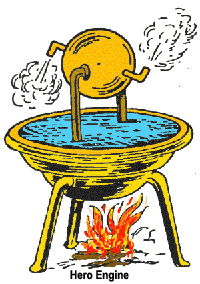300 B.C.
Steam Powered
Rockets
 One
of the first devices to successfully employ the principles essential to rocket
flight was a model pigeon made of wood and suspended from the end of a pivot
bar on wires. The writings of Aulus Gellius, a Roman, tell
the story of a Greek named Archytas who lived in the city of
Tarentum, now a part of southern Italy. Somewhere around the year 300 B.C.,
Archytas mystified and amused the citizens of Tarentum by flying a model pigeon.
Escaping steam propelled the bird, which was suspended on wires. The pigeon
used the same action-reaction principle as the rocket, which was not stated
as a scientific law until the 17th century.
One
of the first devices to successfully employ the principles essential to rocket
flight was a model pigeon made of wood and suspended from the end of a pivot
bar on wires. The writings of Aulus Gellius, a Roman, tell
the story of a Greek named Archytas who lived in the city of
Tarentum, now a part of southern Italy. Somewhere around the year 300 B.C.,
Archytas mystified and amused the citizens of Tarentum by flying a model pigeon.
Escaping steam propelled the bird, which was suspended on wires. The pigeon
used the same action-reaction principle as the rocket, which was not stated
as a scientific law until the 17th century.
About three
hundred years later, another Greek, Hero of Alexandria, invented
a similar rocket-like device called an aeolipile. It, too,
used steam as a propulsive gas.
Hero mounted
a sphere on top of a water basin. A fire below the basin turned the water to
steam, which traveled through pipes and into the sphere. Two L-shaped tubes
on opposite sides of the sphere allowed the steam to escape and provided a thrust
that caused the sphere to rotate.
Close
Window
 One
of the first devices to successfully employ the principles essential to rocket
flight was a model pigeon made of wood and suspended from the end of a pivot
bar on wires. The writings of Aulus Gellius, a Roman, tell
the story of a Greek named Archytas who lived in the city of
Tarentum, now a part of southern Italy. Somewhere around the year 300 B.C.,
Archytas mystified and amused the citizens of Tarentum by flying a model pigeon.
Escaping steam propelled the bird, which was suspended on wires. The pigeon
used the same action-reaction principle as the rocket, which was not stated
as a scientific law until the 17th century.
One
of the first devices to successfully employ the principles essential to rocket
flight was a model pigeon made of wood and suspended from the end of a pivot
bar on wires. The writings of Aulus Gellius, a Roman, tell
the story of a Greek named Archytas who lived in the city of
Tarentum, now a part of southern Italy. Somewhere around the year 300 B.C.,
Archytas mystified and amused the citizens of Tarentum by flying a model pigeon.
Escaping steam propelled the bird, which was suspended on wires. The pigeon
used the same action-reaction principle as the rocket, which was not stated
as a scientific law until the 17th century.